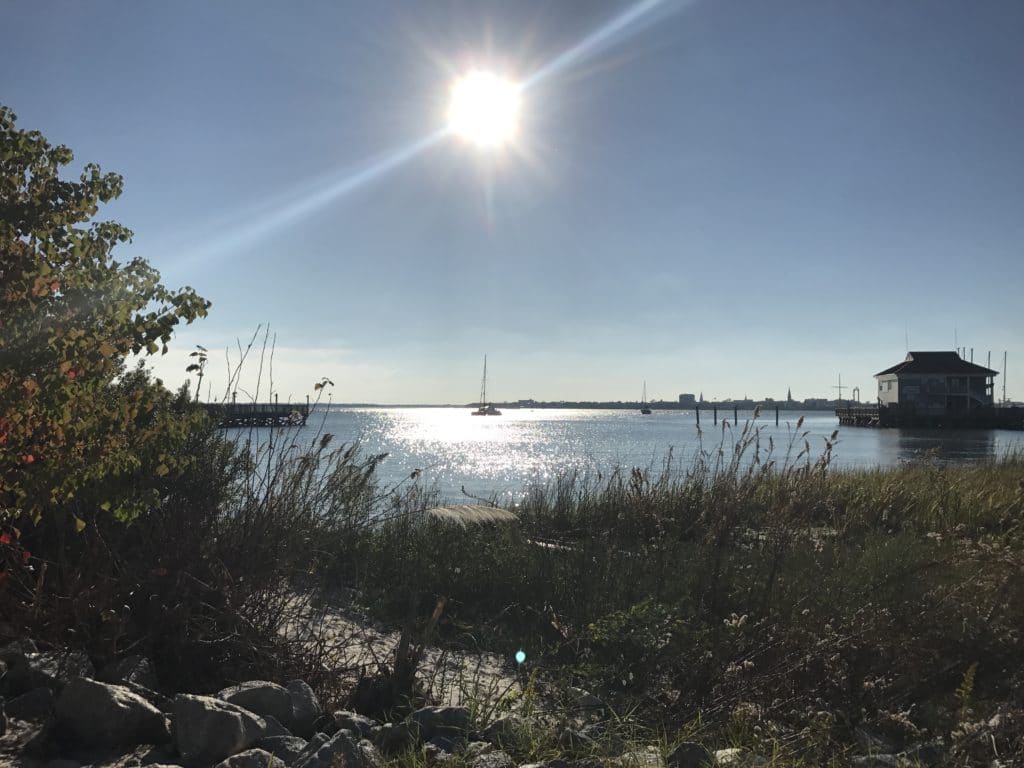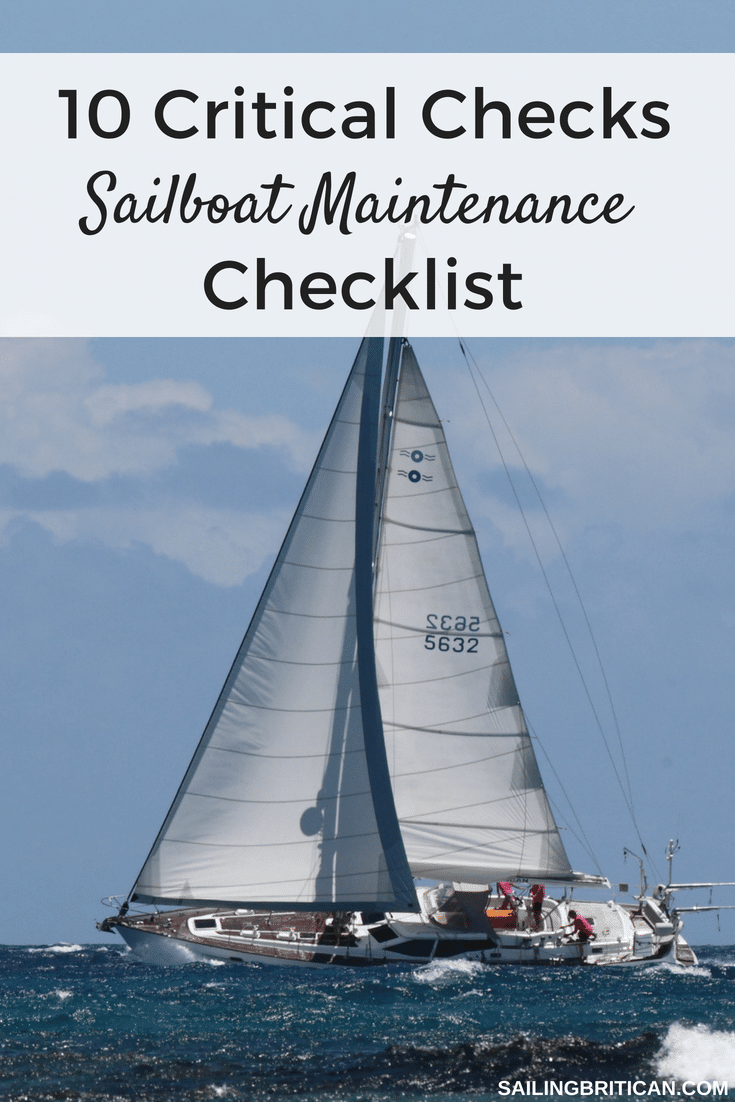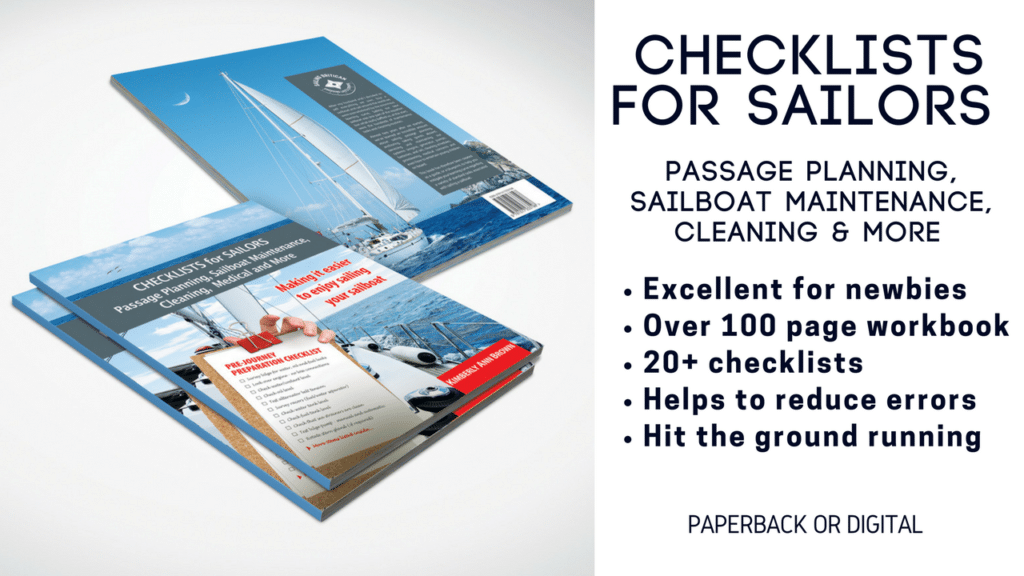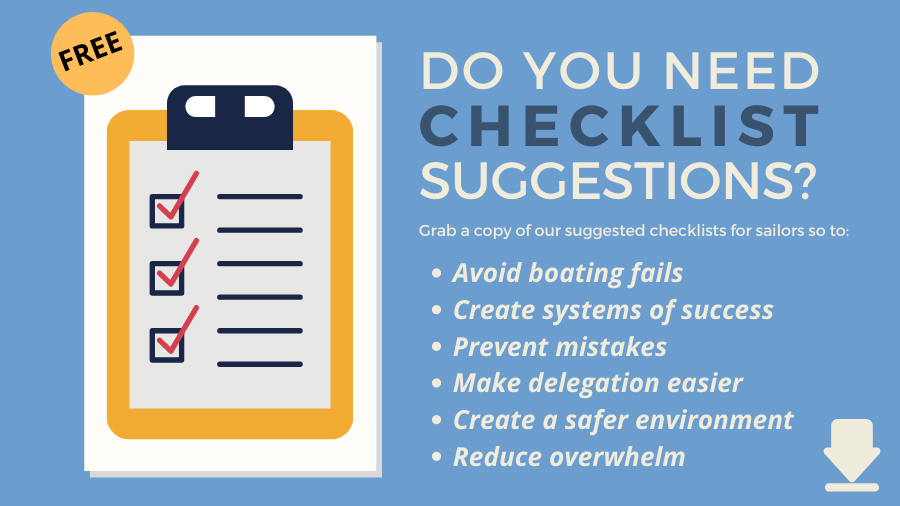When your boat is stationary for any length of time – either at a marina or at anchor, if you’re going to be living on the boat and using the various systems there are several key things to keep an eye on. Below you’ll find a 10-step Sailboat Maintenance Checklist for routine mission-critical daily and/or weekly checks and a video where Simon and I demonstrate the steps.

Note: the below checklist can be found in my guide, ‘Checklists for Sailors: Passage Planning, Sailboat Maintenance, Cleaning, Medical and More’ in addition to 19 other checklists. You can get more information on my guide by clicking on the image below. The guide comes in either digital or hardcopy format and the hardcopy can be shipped within the US. If you’d like to purchase the hardcopy guide outside of the US, you’ll find it on your local Amazon website.
Sailboat Maintenance Checklist – 10 critical tasks
#1 – Survey the Bilge
Every morning, or at least every few days, survey the bilge for water, oil or fuel leaks. It’s good to get in the habit of lifting a central floorboard often just to make sure that the bilge is dry. I especially lift the floorboards after a heavy rainstorm and when turning on the engine or generator if it hasn’t run for a while. Leaks can come from a variety of areas – we’ve had a freshwater shower hose form a slow trickle through to a busted hot water hose causing the floodgates to open. We’ve also had leaks coming from holes in the deck, loose hatch seals and improperly sealed windows.
TIP: The first thing to do when you find a leak is to taste the water. Is it fresh or is it salt?! That is the first clue to start problem-solving…Furthermore, freshwater leaks are manageable but saltwater could be a big issue!
#2 – Test the bilge pump and ensure it’s on automatic
Test that your bilge pump is working to ensure it’s working and ensure it’s on automatic. Bilge pumps are mission-critical. Some boats have engines, batteries, and other valuable systems below the waterline. A leak could become disastrous very quickly if the bilge pump isn’t triggered.
#3 Check the raw water sea strainers
Check your seas strainers! If you’re running your generator, air conditioning/heat, refrigeration, or anything that requires a raw or saltwater cooling system to run, you’ll want to keep an eye on your strainers. Interestingly, we never had to clean our strainers in the Caribbean or Mediterranean but along the east coast of America, we have to clean them weekly.
#4 Ensure all raw water flows are flowing
Check the water flow on all of your raw water cooling systems. Make sure that you can see the aircon/heating/refrigeration/Genset cooling water easily flow out of the boat. As with most of our Sailboat maintenance checklist tasks we’ve learned by experience. One day I noticed our freezer water outflow barely trickling out. I immediately knew there was an issue and was able to fix the problem before it became a disaster 🙂
#5 Check the freshwater level
Our freshwater system is pressurized by an accumulator tank. If and when we get too low it throws our whole system out of whack and it can take hours to get it working correctly again. For us, it’s imperative that we never let our water tanks empty. Another reason to keep an eye on water levels comes down to a decision to ration. If you want to stay at anchor for a few more days yet you’re running out of water, it’s important to reduce water consumption. Or…if you have a watermaker, it might be time to make some water.
#6: Check your battery charge levels every day
Depending on your batteries and the systems you have to keep them charged over time you’ll get to grips with how long you can last without having to take action. Some boats have solar and wind power that constantly tops up the batteries. Other boats, like ours, depend on having our generator running periodically to charge them up. We keep a very close eye on our battery charge level and when the charge level gets low we charge them.
#7: Keep an eye on the Fridge/Freezer Temperature
The effectiveness of a fridge/freezer can often depend on the temperature of the sea that you’re in. In the Med, you might need one setting and then once you get to the Caribbean you’ll have to change it. Furthermore, many boat refrigeration systems get a build-up over time making the unit less and less effective causing the need to slowly reduce the temperature gauge. At least once a week I’m changing our temperature gauge with the goal of keeping the fridge temperature below 5 degrees and the freezer below freezing.
#8: Generator checks
If you’re running the generator often you’ll want to check its vitals at least once a week. Check the oil, water level, belt, and have an overall look around for leaks, loose connections, and any dirt. Keeping the Genset clean will allow you to see leaks easily.
#9: Run your watermaker weekly even if you don’t need water
Depending on what system you have most watermakers need to run at least every 7 to 12 days to keep the system in good shape. While at anchor it’s easy to keep the watermaker active but when entering a marina for a long-ish stay it can be forgotten. If at a marina for longer than the 7 – 12 days temporary pickling can be put in place to preserve the effectiveness of the watermaker.
#10: Dive on your anchor if possible and/or considering re-anchoring and if at a marina, check your warps
If you’re in clear waters and it’s easy to dive on your anchor, go down and check it out. Make sure that it’s firmly set in. Additionally, look at the chain along the seafloor. Over time chain can rub on rocks and get damaged or worse, it can hit a reef and destroy it. Especially in strongly tidal areas, anchors can get dislodged, chains can get tangled in rocks/reef and the ultimate effectiveness of your ground tackle can be compromised. Just because your anchor may have been set for days doesn’t mean that it will always stay set.
And when you’re at a marina, check your warps every time the tide changes. Also, check when the wind starts to blow or before a storm is coming. Conditions change often and although the boat might seem to be docked fine, a change of tide might cause it to become dangerously close to the jetty. Look at the fenders as well. Fenders can pop up unexpectedly.
Sailboat Maintenance Checklist – 10 critical tasks VIDEO
There you have it – the 10 critical daily and/or weekly boat maintenance checks when on anchor or at a marina.
If you have daily or weekly sailboat maintenance checks that you’d like to add, please leave them in the comments below.
If you’d like to be notified weekly of new educational sailing articles and video’s make sure to sign up for my newsletter here.
Are you interested in more information about checklists for sailors?
- Check out all our checklist articles and videos here: Checklists
- Get 50+ Checklist Suggestions here: Suggested Checklists For Sailors
- Also, check out our shop for a variety of guides that include checklists here: Britican Shop



Hi Kim,
Thank you for the checklist. As always, this is informative and useful (for when I get a boat!).
I was horrified to learn that you taste the water in your bilge though. I appreciate that you aren’t talking about a long, thirst-quenching draught but even a tiny amount of water that’s contaminated can make you poorly. Why not put a little of the water in a used (and cleaned) food can and set it on the hob until it’s evaporated? You’ll see if there was any salt in it because the salt will remain in the can. Much safer!
Kind regards,
Peter
That’s a pretty good idea to let the water evaporate, but that could take some time and if the water is from the exterior [salt], that needs to be addressed rather quickly.
She’s not talking about taking a drink of the water. It’s effective enough to simply dip your finger in and then place it on your tongue. You can taste if it’s salty.
Mike
Peter, I agree…ICK…someone needs to develop a salt test strip!
Diana
Great Checklist. thank you. We deal with so many tourist and have to make sure we have all of these. So thank you for the things we need to remember!
As a lad, during an early Outward Bound sailing week in Scotland, we (several teams of 8 or so in traditional, open wooden sailing boats) lost all our food into the bilges during a force 7 storm. We were obliged to dump the perishables, keeping only the tinned food. These tins we washed down thoroughly in seawater.
During our next meal, I chose a tin of pilchards in tomato sauce – which to this day I can’t stomach. This kicked off a vile, 3-day episode of puking and retching, the first of which while being towed back into harbour by our safety boat.
So from minimal of contact with bilgewater, I 1) became as ill as I’ve ever been in my life and 2) I was a liability and missing hand for the duration of a recovery operation.
If you think it through, everything that decays or leaks ends in the bilges. Dead fauna, food fragments, toilet leaks, and anything arriving on shoe soles. Maybe an open boat is a little special, but I now understand bilgewater as a potent bacterial soup to be treated with much the same respect as raw sewage.